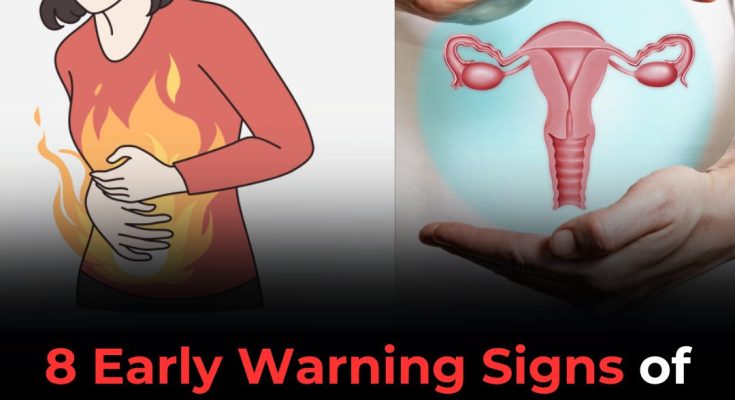Ovarian cancer has been dubbed ‘The Silent Killer’. Similar to many other cancers, it doesn’t show any symptoms for a long time. When it does, the symptoms are very non-specific and can point to a number of different conditions – both serious and benign. The sad reality is that when ovarian cancer is finally diagnosed, it has often already spread, which makes your treatment options limited.
There are some early warning signs you can look out for. But you need to combine your observations with other factors, as you don’t want to be jumping to conclusions too early.
Keep a Healthy Balance Between Denial and Hypochondria
First and foremost, don’t panic. As mentioned before, your symptoms can mean many different things. The chances that you actually have cancer are very small. Ovarian Cancer National Alliance points out that for every 100 women whose symptoms match those of ovarian cancer, only one would actually have early-stage ovarian cancer.
That said, if you do feel something is odd, you shouldn’t just ignore it. People are terrified of cancer and still perceive it as an incurable disease, so they often want to hide from the fact that something is wrong with their bodies. But that of course only makes it worse, as you’re losing precious time. MedicineNet states that only 20 percent of women with ovarian cancer are diagnosed early, when the disease is most curable. So, if you feel that certain symptoms persist and are unusual for you, go and check them out. Better safe than sorry.
The most common type of ovarian cancer includes epithelial tumors, which form in the thin layer of tissue that covers the outside of the ovaries. These tumors occur in 90 percent of cases. The rarer types are stromal tumors, which develop inside the ovaries’ supporting tissue, and germ cell tumors, which begin in the egg-producing cells.
The Eight Most Important Warning Signs of Ovarian Cancer
- Abdominal bloating or swelling: The size of your abdomen increases, you feel bloated and full of gas. You might notice that some clothes feel tighter around your waist and hips.
- Constipation and other changes in your bowel movements.
- Pelvic pain: You feel discomfort or pain in the pelvic area, and sometimes also in the abdomen. If your pain persists, you shouldn’t just brush it away, or mask it with painkillers. Your pain usually wants to give you an important message. There are also other possible causes for this pain.
- Low back pain, especially if it radiates to the pelvic area.
- Urgent or frequent urination: You feel an urgent need to pee and you hardly make it to the toilet on time, and/or you need to urinate in short intervals.
- Loss of appetite or feeling full quickly when you eat: Also observe any unexplained weight loss.
- Pain with sexual activity.
- Fatigue: Feeling overly tired and low in energy can signal an underlying condition.
It doesn’t mean you need to have all of the above symptoms. Sometimes one can be enough to signal there is something suspicious going on. If the symptoms continue for two weeks or longer, it might be time to visit your doctor to check things out.
Ovarian Cancer – Risk Factors
The exact cause of ovarian cancer is not known, but there are some risk factors that can increase your chances of ovarian cancer, so you should consider them.
- Age: Women over the age of 50 are at greater risk of ovarian cancer. About 50 percent of ovarian cancers are diagnosed in women over 60.
- Family history: If you have a family history of ovarian cancer, breast cancer, or colon cancer, that increases your chances of developing ovarian cancer.
- Childbearing and menstruation: Women who have never given birth have a higher risk of developing ovarian cancer, and so do women who started menstruating early or reached menopause late.
- Some medication: Taking hormone therapy after menopause, or using fertility treatment (long-term and large doses) can increase your chances of ovarian cancer.
- Other risk factors: These include smoking, obesity, use of an intrauterine device, and polycystic ovary syndrome.
The Importance of Early Detection and Awareness
One of the major challenges in fighting ovarian cancer is the lack of a reliable screening method. This makes it even more crucial for women to stay informed about their bodies and recognize when something feels off. Unlike breast cancer, which has mammograms for early detection, ovarian cancer remains difficult to detect in its early stages.
Regular Health Checkups: Since ovarian cancer symptoms are often vague, having regular check-ups with your gynecologist can be beneficial. Routine pelvic exams, transvaginal ultrasounds, and CA-125 blood tests may help detect abnormalities.
Genetic Testing: If you have a family history of ovarian or breast cancer, consider genetic testing for BRCA1 and BRCA2 mutations. This can help you assess your risk and take proactive steps in managing your health.
Healthy Lifestyle Choices: Maintaining a balanced diet, exercising regularly, and avoiding known risk factors such as smoking and excessive alcohol consumption can contribute to overall well-being and potentially lower cancer risk.
Scientists continue to work on developing a better detection method for early-stage ovarian cancer. Until then, take time to get to know your body, look after it, listen to it, and try to feel when something is wrong. That will probably be one of your best assets in combating any disease in its early stages.
Some of the above-mentioned warning signs can also be signs of cervical cancer. To learn more about the risk factors and warning signs of cervical cancer, read my article on this subject: 10 Warning Signs of Cervical Cancer You Shouldn’t Ignore.
Read These Related Articles:
- Ovary Pain and Lower Pelvic Pain – 13 Possible Causes
- 9 Reasons Not to Ignore Spotting Before Period
- Uterine (Endometrial) Cancer – Symptoms, Risk Factors and Prevention
Our Mission
At Healthy and Natural World, our mission is to empower people to take control of their own health by providing comprehensive, practical, and well-researched information.
We strive to be objective, unbiased, and honest, presenting both sides of the argument. Our articles contain scientific references which are numbered. Some of the references are clickable, and others are found at the end of the article. The references are linked to peer-reviewed scientific papers or authoritative medical sites.
Disclaimer: Our content does not constitute a medical consultation. If you have a medical problem, you should seek advice from a doctor or another healthcare professional.
We occasionally link to products offered by vendors to help readers find relevant items. When you buy through these links, we may earn an affiliate commission. As an Amazon Associate, we earn from qualifying purchases. For more details, please see our Full Disclaimer and Privacy Policy.
The entire content of this website is copyrighted and should not be copied without permission.



